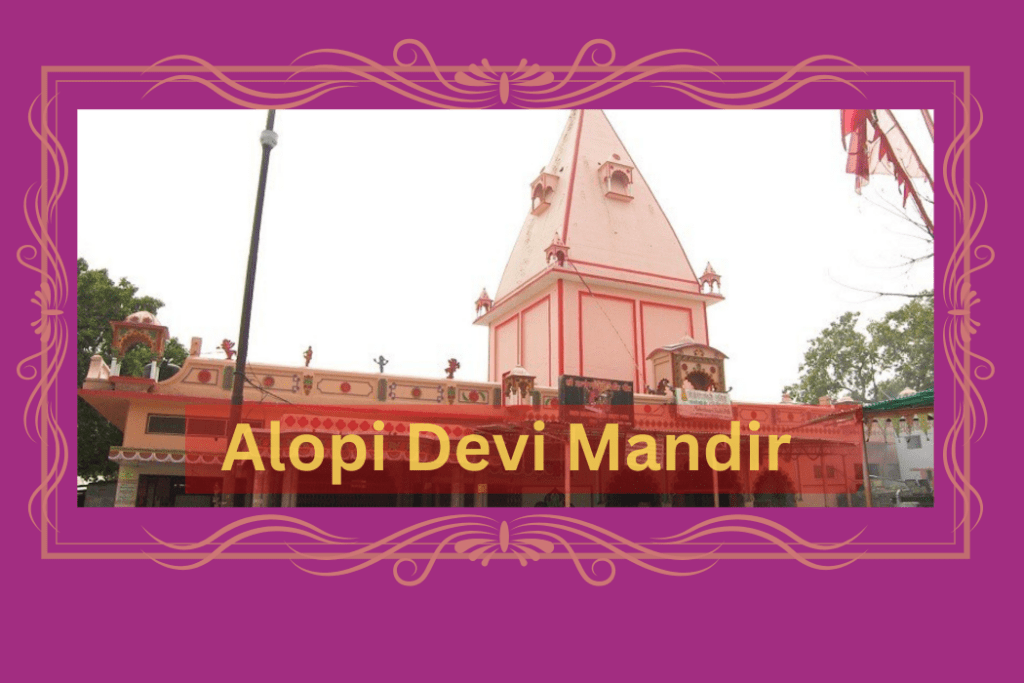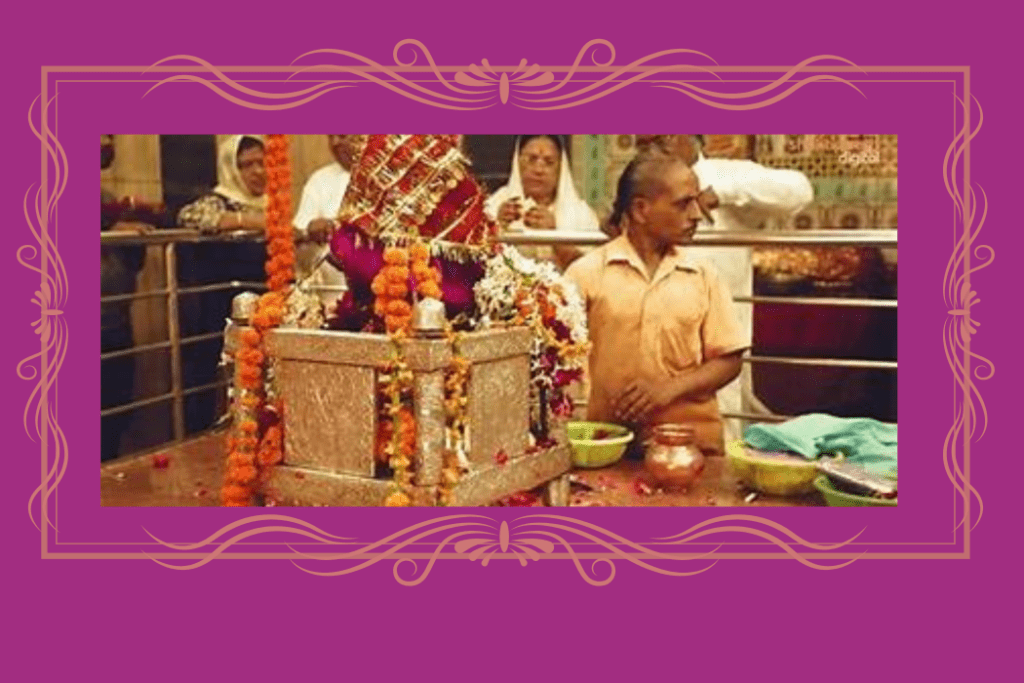Alopi Devi Mandir, Prayagraj: History, Significance, and Travel
In this blog, we talk about the history, design, amazing places to visit, and the peaceful feeling that makes Alopi Devi Mandir a really great place to go.

The Alopi Devi Mandir is located in Prayagraj, India. It’s in a place called Alopibagh. The temple has a long history. Later, in the 1800s, Maharani Baizabai helped renovate the ghats (bathing steps) and temples around the Sangam, including the Alopi Devi Mandir. Many people who live in the area visit the Alopi Devi Temple.
The Alopi Devi temple in Prayagraj is known for its unique yet simple beauty. Unlike many other temples that are grand and ornate, Alopi Devi embraces a more humble and peaceful design. The temple building itself has clean lines and a straightforward structure. This creates a sense of calmness and quiet reflection for visitors.
In this blog, we talk about the history, design, amazing places to visit, and the peaceful feeling that makes Alopi Devi Mandir a really great place to go.
| Participate in online puja organised by VAMA(Get the puja done with your name and gotra) | |
| Name of Puja | Temple (Place) |
| Rin Mukti Puja | Rin Mukteshwar Mahadev Temple (Ujjain) |
| Shani Sade Sati | Shani Shingnapur Devsthanam ,Maharashtra |
| Rahu Grah Shanti Puja | Jarkutinatheshwar Mahadev Temple,Prayagraj |
| Bal Gopal Santaan Prapti Puja | Vrindavan Dham Kshetra ,Vrindavan |
| Sunderkand Path Rasraj Ji Maharaj ke sath | Lete Huye Hanuman Mandir,Prayagraj |
Want to know about Ek Mukhi Rudraksha? Read this blog – Ek Mukhi Rudraksha Mala: Know its Meaning, Benefits, and Significance
History and Story Behind the Alopi Devi Temple
The Connection to Goddess Sati
One belief is that Alopi Devi Mandir Prayagraj marks the spot where Sati’s fingers landed and then disappeared, signifying her complete merging with the divine. Another belief claims it to be the site where the last piece of her body fell.
The Legend of the Disappearing Bride
During those times, weddings were frequent targets for robberies. The bandits killed the men and stole their valuables. When they approached the bride’s palanquin (carriage), they were astonished to find it empty! The bride had mysteriously vanished.
This miraculous disappearance led to rumours and stories, eventually evolving into the belief that the bride wasn’t a human, but a divine being who had chosen to disappear. The locals built a temple at the spot and started worshipping her as Alopi Devi, meaning “the disappearing goddess.”
Architecture of Alopi Devi Temple
The roof of the temple has a classic cone shape, similar to other temples in the region. This connects the Alopi Devi temple to its cultural surroundings and history. Inside the most sacred part of the temple, called the “sanctum sanctorum”, there is no traditional statue of a deity like you might find in other temples. Instead, a unique symbol represents the goddess: a wooden palanquin, also known as a “doli”. This palanquin, placed on a beautiful marble stand, signifies the presence of Alopi Devi.

Spiritual Significance and Festivals
Navratri, a nine-day Hindu festival honouring the divine feminine, turns the sacred halls of Alopi Devi Mandir in Prayagraj into a display of colourful devotion. For numerous followers, the Alopi Devi Temple exerts a strong attraction as they set off on religious journeys. This time goes beyond just worship, turning into an enchanting fabric created with faith, tradition, and a feeling of togetherness.
The usual simplicity of everyday life is replaced with a burst of vibrant colours as worshipers come dressed in their best clothes. The temple grounds are adorned with bright oranges, iridescent blues, and deep greens, reflecting the festival’s liveliness.
Women, embellished with elaborate henna patterns and vibrant bangles, contribute to the aesthetic delight. Men, dressed in traditional kurtas and dhotis, add to the overall visual display. The blending of colours forms a visually striking introduction to the spiritual experience that lies inside the temple.
The atmosphere is filled with the ringing of temple bells and the soothing chants of worshippers. Upon entering the sanctum, they bring offerings with their hands full, signifying respect and thankfulness. Fragile flower wreaths, symbolising purity and beauty, decorate the rocking cradle that represents the Goddess.

Visiting Alopi Devi Mandir Prayagraj is more than just a practical task; it is a fundamental aspect of the pilgrimage journey. Whether you fly above the clouds, travel on train tracks, or drive on busy streets, every form of transportation provides a different viewpoint during the trip. By planning ahead and being receptive, your visit to Alopi Devi Mandir can be just as rewarding as the blessings you hope to receive there.
Tourist attractions around the Alopi Devi Temple
Alopi Devi Temple is a divine place, but there are more places in Prayagraj where you can visit too! Here are some exciting things you can do around the temple:
1. Take a bath in river ganga: Just a short distance from the Alopi Devi Mandir, you can find the majestic Ganges, which is considered India’s most sacred river. Close to the Someshwar Nath Temple, specific ghats attract visitors wanting to take a holy dip in the life-giving waters. Engage in this ancient practice, thought to cleanse sins and bestow blessings.
2. Explore the city: Prayagraj is vibrant with the liveliness of a busy urban centre. Go outside the temple area and discover the lively streets filled with adorable stores.Treat your inner shopaholic to a variety of items such as traditional handloom textiles, intricately crafted jewellery, and souvenirs that embody the spirit of the city.
3. Visit the Allahabad Fort: Start your journey through history by researching the strongholds, gateways, and courtyards. Ascend the stronghold to reach its peak and enjoy breathtaking panoramic vistas of Prayagraj and the winding Ganges River glistening as it winds its way through the city.
How to Reach the Alopi Devi Temple?
Getting to this sacred location can involve both physical and spiritual discovery. This guide explores the different travel choices for a successful and rewarding pilgrimage.
By Flight
The temple is around 16 kilometres away from Prayagraj Airport (IXD). Major airline companies offer frequent flights linking Prayagraj to major cities such as Delhi, Mumbai, Kolkata, and Chennai.
Upon arrival at Prayagraj Airport, you will have a range of choices for surface transportation available to you.
Plan ahead for the expenses to guarantee a reasonable price. Although rickshaws are inexpensive, remember that they could have a slower travel time to the temple in comparison to taxis.
By Train
The main station of Prayagraj is Prayagraj Junction (PRYJ). Besides Delhi, Mumbai, Kolkata, Chennai, Varanasi, and Agra, it also has excellent connections to other major Indian cities.
If you plan to travel during busy times or during special events, it is best to make your arrangements in advance. If you need train tickets, you can purchase them online or from the station.
By Road
For individuals looking for an affordable choice, they can choose the bus option to visit the temple. Prayagraj has multiple bus stands. These centres link Prayagraj with different cities throughout India.
Frequently Asked Questions
Where is Alopi Devi Mandir Located?
The Alopi Devi Temple is located in Prayagraj, India. The temple has a long history. According to some evidence, a Maratha warrior named Shreenath Mahadji Shinde helped develop the Sangam area when he visited Prayagraj in the 1770s.
What is the Architecture of Alopi Devi Mandir?
The Alopi Devi temple in Prayagraj is known for its unique yet simple beauty. Unlike many other temples that are grand and ornate, Alopi Devi embraces a more humble and peaceful design. The temple building itself is designed with clean lines and a straightforward structure. This creates a sense of calmness and quiet reflection for visitors.
What is the best time to visit Alopi Devi Mandir?
Ultimately, the best time to visit Alopi Devi Mandir Prayagraj depends on what you seek from your pilgrimage. Whether it’s a serene escape in pleasant weather or an immersive experience amidst the fervour of festivals, this guide equips you to make an informed decision. Remember, the temple welcomes devotees year-round, and the divine presence of Alopi Devi is ever-lasting.
Want to know about Panch Mukhi Rudraksha? Read this blog – Panch Mukhi Rudraksha Mala: Know its Meaning, Benefits, and Significance




